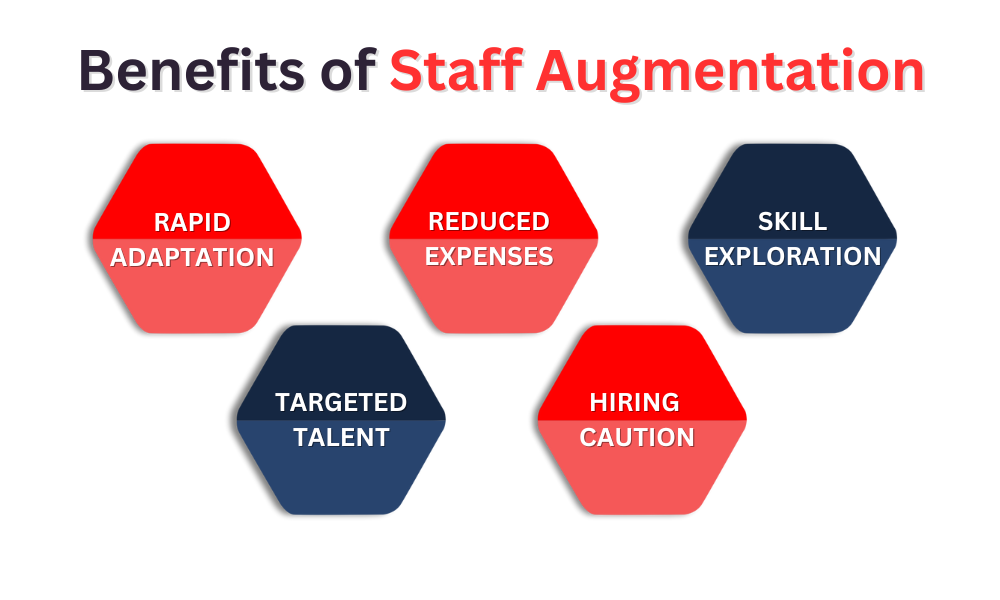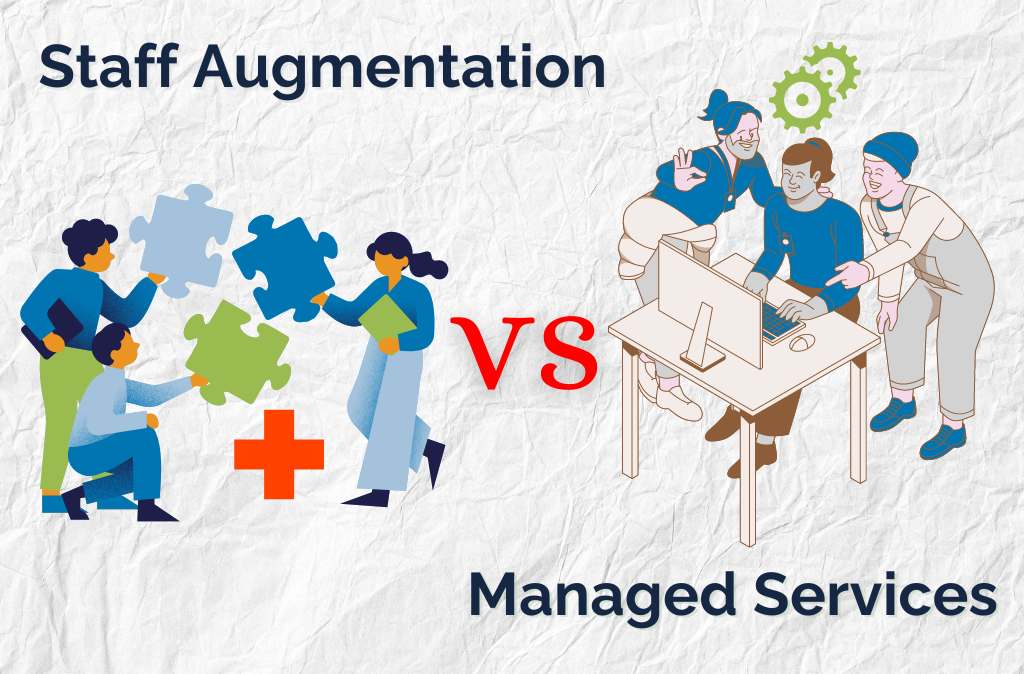Key Points
- Staff Augmentation and Managed Services are two popular outsourcing models that help businesses streamline operations, lower expenses, and tap into specialized knowledge.
- Staff augmentation allows for greater flexibility and scalability compared to managed services, providing a cost-effective solution for short-term business requirements.
- Before selecting the best option for their needs, organizations should evaluate the pros and cons of both options and assess their business needs to determine which model is most appropriate.
Staff Augmentation vs. Managed Services – What are these?
Outsourcing has become a crucial tactic for numerous businesses aiming to simplify operations, lower expenses, and tap into specialized knowledge. Two main outsourcing approaches are staff augmentation and managed services, both tailored to meet specific business needs and demands.
Staff augmentation concentrates on supplying extra staff to carry out a project or address skill gaps, whereas managed services involve contracting out an external party to handle and maintain a particular function or process.
Before proceeding, let’s take a moment to introduce ourselves. We are known for providing top-notch professionals who take responsibility for managing your business services. Our team excels in handling complex projects and filling talent shortages and skill gaps with speed and precision.
At Invedus, we support both business models at affordable prices. Our team is experienced in understanding the tax and financial processes of your countries, especially English and Scandinavian countries. The best part is the professionals are proficient in these languages, so you’ll not feel a communication lag.
To assist you in making the best choice for your company, let’s delve deeper into these two outsourcing models.
Staff Augmentation
This model involves temporarily hiring external personnel to supplement a business’s existing team.
This can help fill skill gaps, handle increased workloads, or address specific obstacles. Businesses can maintain direct oversight of the augmented staff.
Staff augmentation can be cost-effective and flexible, as businesses can quickly acquire new skills and capabilities without permanently hiring additional staff.
Benefits and Hangups of Staff Augmentation

Staff augmentation, the practice of hiring temporary workers to supplement an existing workforce, offers both advantages and challenges. Let’s find out what these are:
Benefits of Staff Augmentation
- Scalability: Without the hassle of recruiting and onboarding permanent staff, businesses can quickly adapt their workforce to meet changing demands.
- Cost-Effectiveness: Avoid the long-term costs associated with full-time employees, such as benefits and payroll taxes.
- Flexibility: Try out new skills or departments without committing to a permanent hire.
- Specialized Expertise: Access highly skilled professionals for specific projects or tasks.
- Lower Risk: In times of economic recession, reduce the possibility of overhiring.
Hangups of Staff Augmentation
- Integration With Internal Team Takes Time
Temporary employees may need time to acclimate to the company culture and work processes.
- You Have a Bit Less Control Over Your Hiring Choice
You may have less control over the performance and availability of temporary staff.
However, don’t worry about this issue when you hire staff from Invedus. You have full access to control your team. We are dedicated to delivering the best to our clients.
- Administrative Burden: Managing temporary workers can add to your administrative workload.
When to Consider Staff Augmentation:
- Short-term projects or peak seasons.
- Specific skill sets or expertise not available in-house.
- Need to quickly scale up or down the workforce.
- Testing out a new role or department before making a permanent hire.
Managed Services
This outsourcing model involves outsourcing the management and maintenance of a specific function or process to an external provider, known as a managed services provider (MSP).
Managed services involve outsourcing business functions to a third-party provider for long-term support and maintenance, covering functions such as cloud infrastructure maintenance, security, backup recovery, and platform migration.
A managed service provider is responsible for overseeing the program and ensuring smooth operations and compliance with service-level agreements. This model is cost-effective.
It’s crucial to choose the right provider to avoid significant issues and misaligned objectives.
Benefits and Hangups of Managed Services
Managed services offer a range of advantages and potential drawbacks. Understanding these can help businesses determine if such a model is suitable for their needs.
Benefits of Managed Services
You’ll Save Your Time and Cost
By outsourcing IT functions, businesses can often achieve cost savings due to economies of scale and specialized expertise.
You no longer need to worry about team scalability.
In a staff augmentation model, you spend a lot of time managing team scalability, but in a managed service model, you don’t have to worry about it. Your outsourcing partner will take care of this for you. You just need to submit your requirements to them.
Minimize Business Risk Without Concerning Yourself About Data Protection
Managed service providers often have robust security measures and disaster recovery plans in place, mitigating risks and protecting business data.
Dedication to Project Delivery
With this outsourcing model, they commit to helping their clients grow their businesses.
Long-Term Planning
Managed service providers use the outsourcing model specifically to avail their services for the long term.
Hangups of Managed Services
Sometimes, communication gaps arise due to different time zones. However, this occurs very rarely.
On the contrary, the managed service team is proficient in your native language, which avoids almost all communication hurdles and ensures that your project will proceed smoothly.
Staff Augmentation and Managed Services: A Comparison of the Two Outsourcing Models
To gain a better understanding of the distinctions between staff augmentation and managed services, it is necessary to compare them in terms of flexibility, costs, and control.
Staff augmentation focuses on supplying additional professionals and expertise to carry out a project or bridge a skills gap, while managed services entail contracting out the management and upkeep of a particular function or process to an external provider.
When it comes to flexibility, then staff augmentation offers greater flexibility, as it allows for the addition of professionals to a team for specific projects or periods.
In the context of flexibility, staff augmentation offers greater adaptability, as it allows the integration of staff into an existing team for a specific project or duration.
Managed services are more cost-efficient, as they involve outsourcing the management and maintenance of a specific function or process to an external provider.
In terms of control, staff augmentation provides organizations with more oversight over their projects, while managed services give providers more control over the services they deliver.
Other than that, these are different in other aspects as well. Let’s find out what these are.
1. Flexible and Scalable
A certain amount of flexibility is provided by both managed services and staff augmentation. If your onsite team is loaded with the workload, then staff augmentation will benefit you most from the additional support or specialized skills.
Scale your outsourced team easily with your onsite team using staff augmentation. But with managed services, you can monitor the progress of your project without the onsite team getting involved.
On the other hand, MSPs typically require you to pay a retainer fee and might however not let you scale your team up or down as needed.
2. Cost and Budget Factor
When it comes to costs and budgeting, undoubtedly staff augmentation is best. As you only need to pay for the hours or time duration, you availed of the services provided by your chosen accounting professional.
Yes, this outsourcing model works perfectly when you are short on your onsite team and need a skill gap or a specific project.
On the contrary, yes, you are paying a high amount to your MSP provider, but not as much as you think.
You use this managed services outsourcing model for a long-term goal and higher profit. However, they will have to reimburse you for the favorable outcome for your company.
You do not have to spend money on employee training, extra expenses (like vacation pay, medical costs, and other costs), or the newest machinery and technology.
When opting for a managed services provider, try not to focus solely on high prices. By choosing this option, you can hire a full-fledged team with expertise at an affordable rate. Additionally, they are responsible for contributing to the growth of your business.
3. Oversight and Project Control
Staff augmentation gives organizations more control over their projects in terms of oversight and control.
Clients can select specific tasks and determine the timeline for completion, ensuring that the project meets their expectations and requirements.
With this degree of control, organizations can closely track the development of their projects and make necessary adjustments to stay on schedule and within budget.
However, on the contrary, by choosing managed services, the provider gains increased control over the project and assumes responsibility for ensuring successful service delivery.
This may necessitate organizations to cede some control to the provider, potentially leading to a shift in project management and execution approaches.
However, managed services providers typically possess substantial experience and expertise, ensuring efficient and effective management of the outsourced functions.
4. Data Security
When it comes to data, anyone involved must take responsibility for its security. Whether you are working with staff-augmented or managed services outsourcing models, both are equally responsible for keeping your data safe. It doesn’t matter which outsourcing model you choose to accomplish your tasks.
So, don’t worry about it. Your data is completely safe with Invedus professionals. They take responsibility for managing and securing your credentials. No matter which model you choose.
Wrapping of Words
Staff augmentation can be a valuable tool for businesses that need to flex their workforce and access specialized skills.
In contrast, managed services assume full responsibility for handling your project, regardless of whether you started it from scratch or just handed it off to them midway. No matter, they take complete responsibility for scaling teams, cost management, usage of the latest tools and technologies, team management, and everything.
However, it’s important to carefully consider the potential drawbacks and weigh them against the benefits before making a decision.
You can decide whether managed services or staff augmentation is the best option for your company by being aware of the benefits and drawbacks of each.
At Invedus, we offer a wide range of outsourcing services to clients globally at highly affordable prices. Reach out to us and grow your company by leveraging our experience and expertise!







